Analysis of Legislation and Rights in Health and Social Care Report
VerifiedAdded on 2020/01/07
|11
|3691
|540
Report
AI Summary
This report examines the crucial role of legislation, policies, and codes of practice in health and social care, emphasizing the empowerment of service users. It analyzes how legislation, such as the Human Rights Act 1998 and the Care Standards Act 2000, safeguards user rights and influences organizational practices. The report explores factors affecting the promotion of these rights, including staff training, communication, and cultural understanding, using a case study to highlight potential barriers. It also investigates how communication between care workers and individuals contributes to maximizing user rights, promoting independence, and preventing social exclusion. Furthermore, it addresses the tensions between individual rights and care providers' duties, particularly regarding patient safety and medication management, and evaluates the effectiveness of related policies and procedures within a health and social care setting. The report underscores the importance of balancing these aspects to ensure comprehensive and effective care.
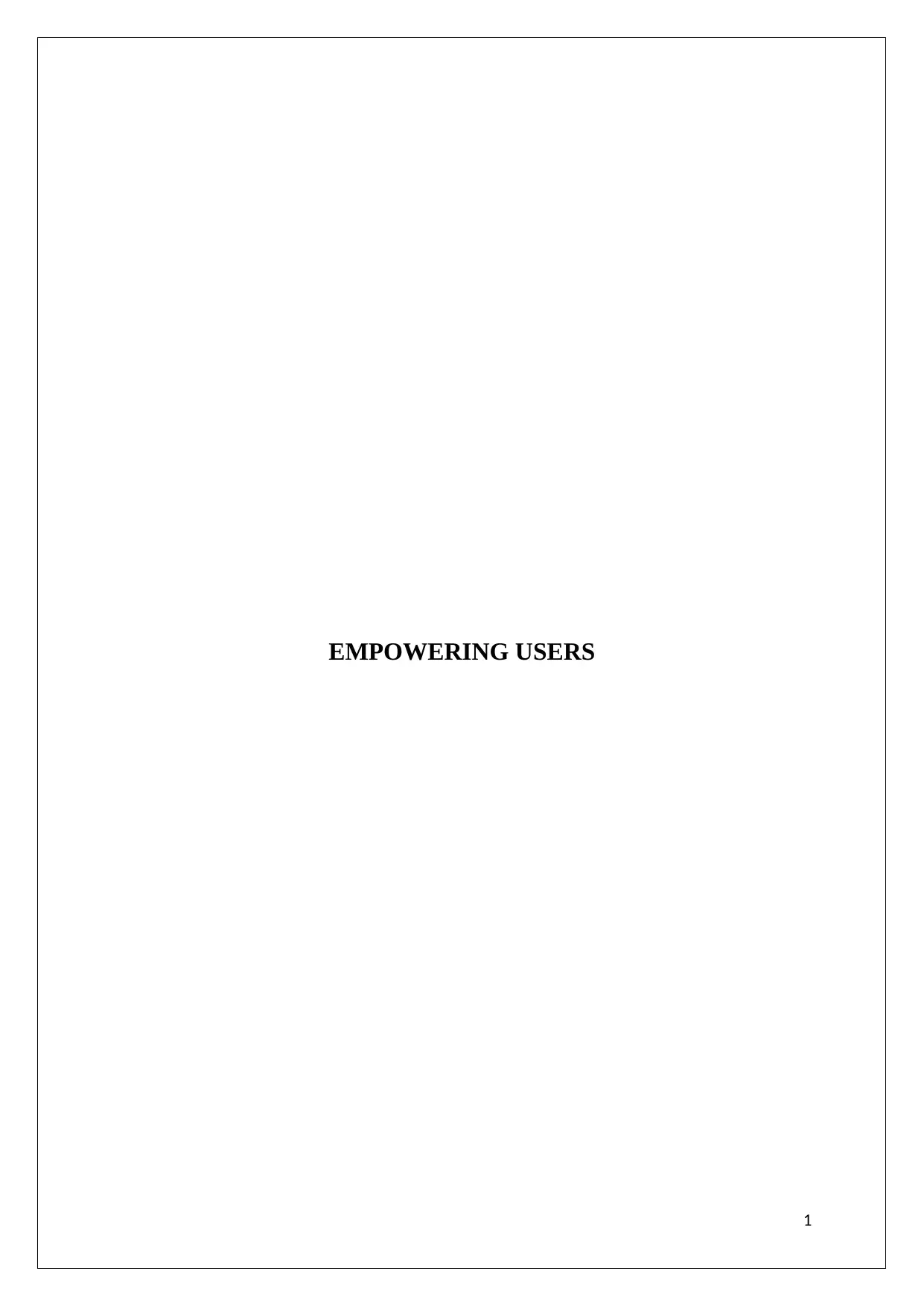
EMPOWERING USERS
1
1
Paraphrase This Document
Need a fresh take? Get an instant paraphrase of this document with our AI Paraphraser
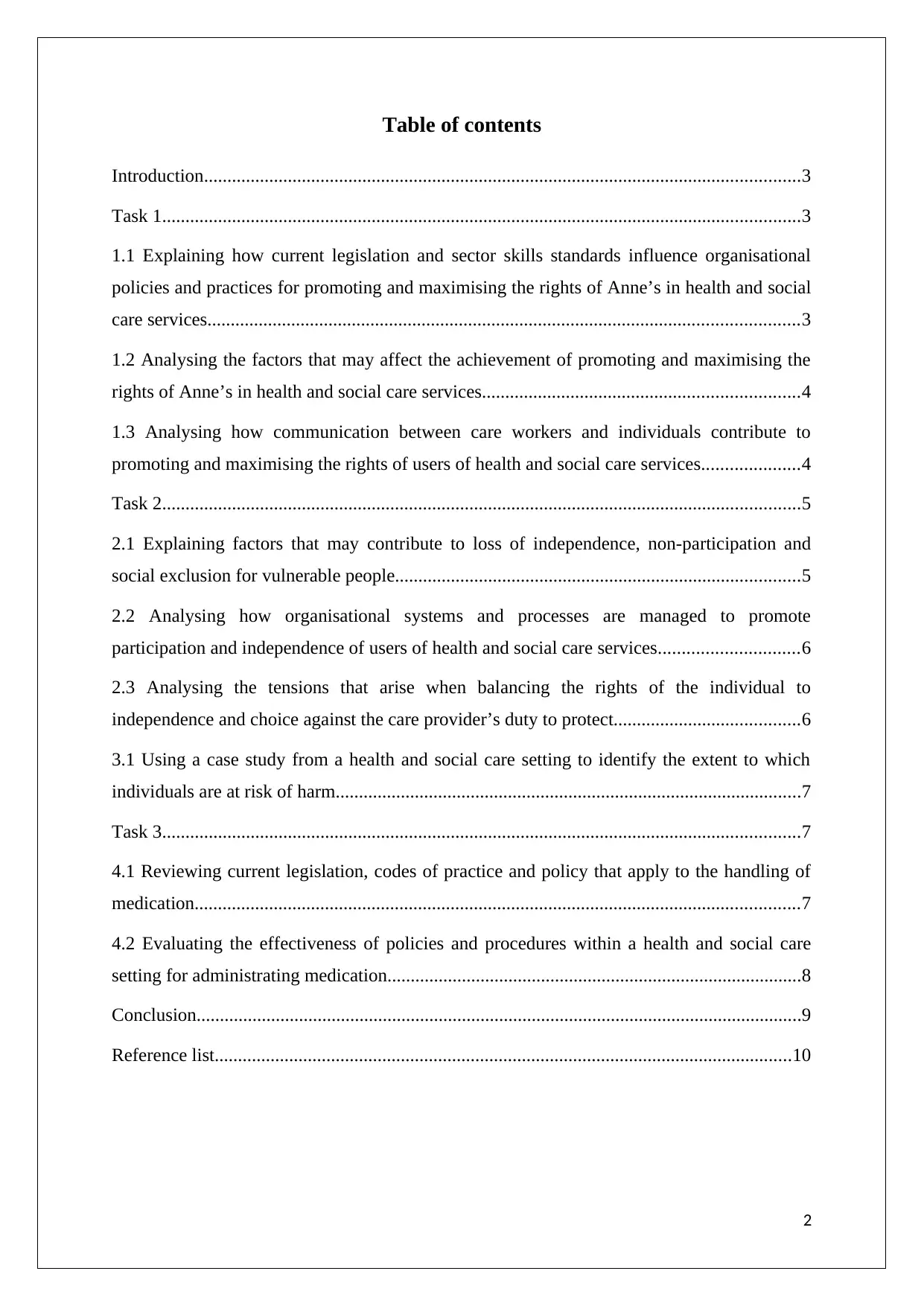
Table of contents
Introduction................................................................................................................................3
Task 1.........................................................................................................................................3
1.1 Explaining how current legislation and sector skills standards influence organisational
policies and practices for promoting and maximising the rights of Anne’s in health and social
care services...............................................................................................................................3
1.2 Analysing the factors that may affect the achievement of promoting and maximising the
rights of Anne’s in health and social care services....................................................................4
1.3 Analysing how communication between care workers and individuals contribute to
promoting and maximising the rights of users of health and social care services.....................4
Task 2.........................................................................................................................................5
2.1 Explaining factors that may contribute to loss of independence, non-participation and
social exclusion for vulnerable people.......................................................................................5
2.2 Analysing how organisational systems and processes are managed to promote
participation and independence of users of health and social care services..............................6
2.3 Analysing the tensions that arise when balancing the rights of the individual to
independence and choice against the care provider’s duty to protect........................................6
3.1 Using a case study from a health and social care setting to identify the extent to which
individuals are at risk of harm....................................................................................................7
Task 3.........................................................................................................................................7
4.1 Reviewing current legislation, codes of practice and policy that apply to the handling of
medication..................................................................................................................................7
4.2 Evaluating the effectiveness of policies and procedures within a health and social care
setting for administrating medication.........................................................................................8
Conclusion..................................................................................................................................9
Reference list............................................................................................................................10
2
Introduction................................................................................................................................3
Task 1.........................................................................................................................................3
1.1 Explaining how current legislation and sector skills standards influence organisational
policies and practices for promoting and maximising the rights of Anne’s in health and social
care services...............................................................................................................................3
1.2 Analysing the factors that may affect the achievement of promoting and maximising the
rights of Anne’s in health and social care services....................................................................4
1.3 Analysing how communication between care workers and individuals contribute to
promoting and maximising the rights of users of health and social care services.....................4
Task 2.........................................................................................................................................5
2.1 Explaining factors that may contribute to loss of independence, non-participation and
social exclusion for vulnerable people.......................................................................................5
2.2 Analysing how organisational systems and processes are managed to promote
participation and independence of users of health and social care services..............................6
2.3 Analysing the tensions that arise when balancing the rights of the individual to
independence and choice against the care provider’s duty to protect........................................6
3.1 Using a case study from a health and social care setting to identify the extent to which
individuals are at risk of harm....................................................................................................7
Task 3.........................................................................................................................................7
4.1 Reviewing current legislation, codes of practice and policy that apply to the handling of
medication..................................................................................................................................7
4.2 Evaluating the effectiveness of policies and procedures within a health and social care
setting for administrating medication.........................................................................................8
Conclusion..................................................................................................................................9
Reference list............................................................................................................................10
2
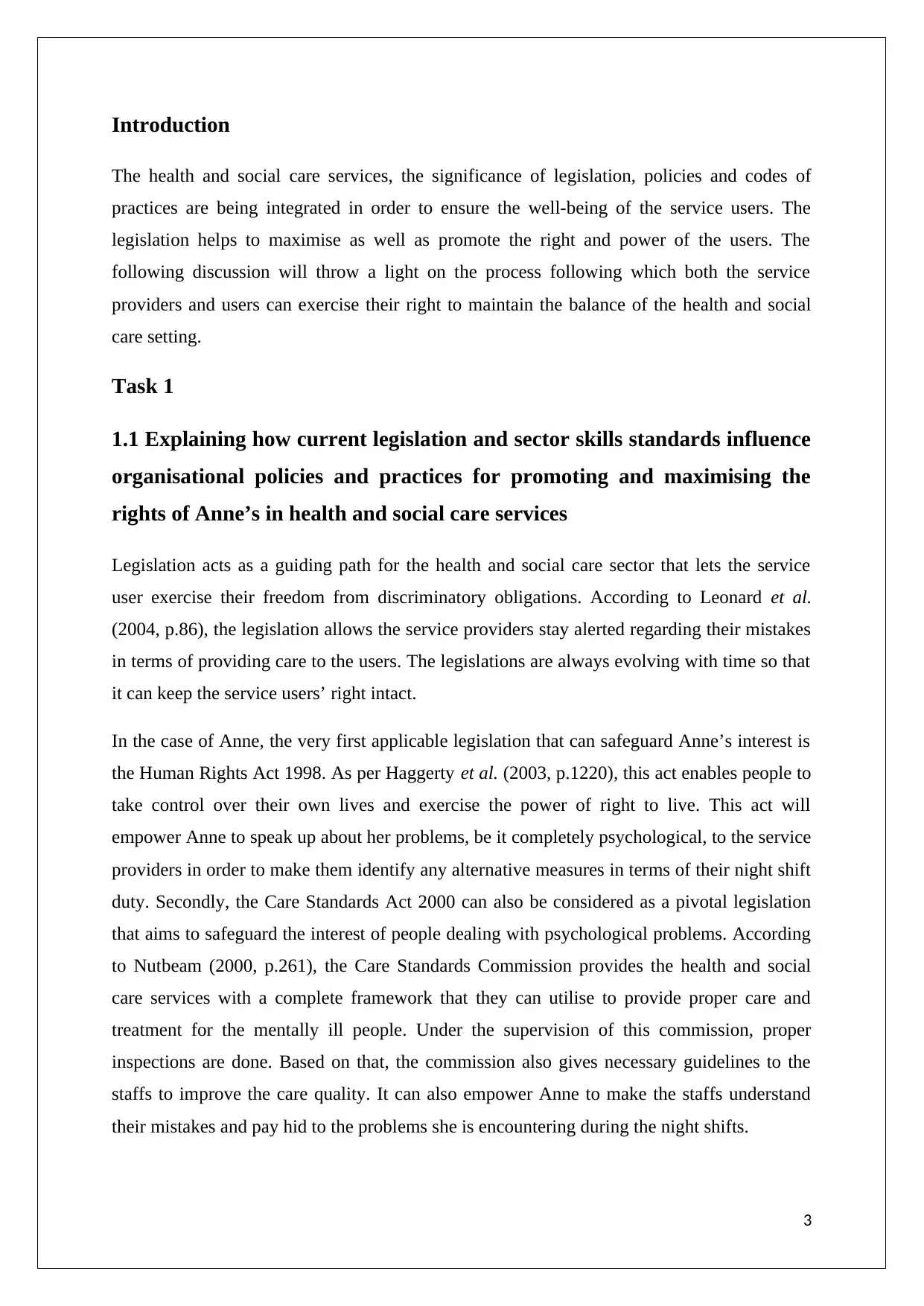
Introduction
The health and social care services, the significance of legislation, policies and codes of
practices are being integrated in order to ensure the well-being of the service users. The
legislation helps to maximise as well as promote the right and power of the users. The
following discussion will throw a light on the process following which both the service
providers and users can exercise their right to maintain the balance of the health and social
care setting.
Task 1
1.1 Explaining how current legislation and sector skills standards influence
organisational policies and practices for promoting and maximising the
rights of Anne’s in health and social care services
Legislation acts as a guiding path for the health and social care sector that lets the service
user exercise their freedom from discriminatory obligations. According to Leonard et al.
(2004, p.86), the legislation allows the service providers stay alerted regarding their mistakes
in terms of providing care to the users. The legislations are always evolving with time so that
it can keep the service users’ right intact.
In the case of Anne, the very first applicable legislation that can safeguard Anne’s interest is
the Human Rights Act 1998. As per Haggerty et al. (2003, p.1220), this act enables people to
take control over their own lives and exercise the power of right to live. This act will
empower Anne to speak up about her problems, be it completely psychological, to the service
providers in order to make them identify any alternative measures in terms of their night shift
duty. Secondly, the Care Standards Act 2000 can also be considered as a pivotal legislation
that aims to safeguard the interest of people dealing with psychological problems. According
to Nutbeam (2000, p.261), the Care Standards Commission provides the health and social
care services with a complete framework that they can utilise to provide proper care and
treatment for the mentally ill people. Under the supervision of this commission, proper
inspections are done. Based on that, the commission also gives necessary guidelines to the
staffs to improve the care quality. It can also empower Anne to make the staffs understand
their mistakes and pay hid to the problems she is encountering during the night shifts.
3
The health and social care services, the significance of legislation, policies and codes of
practices are being integrated in order to ensure the well-being of the service users. The
legislation helps to maximise as well as promote the right and power of the users. The
following discussion will throw a light on the process following which both the service
providers and users can exercise their right to maintain the balance of the health and social
care setting.
Task 1
1.1 Explaining how current legislation and sector skills standards influence
organisational policies and practices for promoting and maximising the
rights of Anne’s in health and social care services
Legislation acts as a guiding path for the health and social care sector that lets the service
user exercise their freedom from discriminatory obligations. According to Leonard et al.
(2004, p.86), the legislation allows the service providers stay alerted regarding their mistakes
in terms of providing care to the users. The legislations are always evolving with time so that
it can keep the service users’ right intact.
In the case of Anne, the very first applicable legislation that can safeguard Anne’s interest is
the Human Rights Act 1998. As per Haggerty et al. (2003, p.1220), this act enables people to
take control over their own lives and exercise the power of right to live. This act will
empower Anne to speak up about her problems, be it completely psychological, to the service
providers in order to make them identify any alternative measures in terms of their night shift
duty. Secondly, the Care Standards Act 2000 can also be considered as a pivotal legislation
that aims to safeguard the interest of people dealing with psychological problems. According
to Nutbeam (2000, p.261), the Care Standards Commission provides the health and social
care services with a complete framework that they can utilise to provide proper care and
treatment for the mentally ill people. Under the supervision of this commission, proper
inspections are done. Based on that, the commission also gives necessary guidelines to the
staffs to improve the care quality. It can also empower Anne to make the staffs understand
their mistakes and pay hid to the problems she is encountering during the night shifts.
3
⊘ This is a preview!⊘
Do you want full access?
Subscribe today to unlock all pages.

Trusted by 1+ million students worldwide
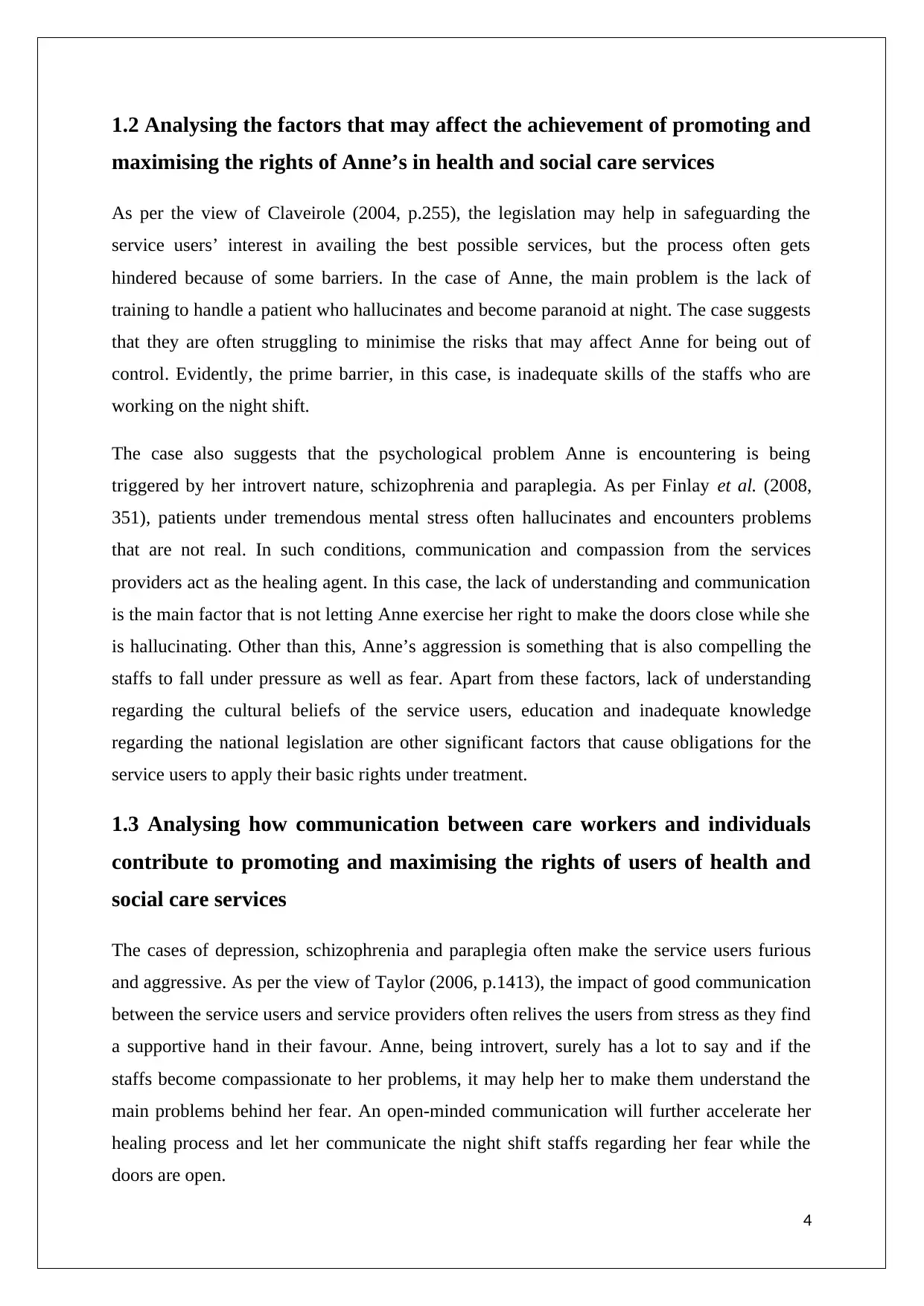
1.2 Analysing the factors that may affect the achievement of promoting and
maximising the rights of Anne’s in health and social care services
As per the view of Claveirole (2004, p.255), the legislation may help in safeguarding the
service users’ interest in availing the best possible services, but the process often gets
hindered because of some barriers. In the case of Anne, the main problem is the lack of
training to handle a patient who hallucinates and become paranoid at night. The case suggests
that they are often struggling to minimise the risks that may affect Anne for being out of
control. Evidently, the prime barrier, in this case, is inadequate skills of the staffs who are
working on the night shift.
The case also suggests that the psychological problem Anne is encountering is being
triggered by her introvert nature, schizophrenia and paraplegia. As per Finlay et al. (2008,
351), patients under tremendous mental stress often hallucinates and encounters problems
that are not real. In such conditions, communication and compassion from the services
providers act as the healing agent. In this case, the lack of understanding and communication
is the main factor that is not letting Anne exercise her right to make the doors close while she
is hallucinating. Other than this, Anne’s aggression is something that is also compelling the
staffs to fall under pressure as well as fear. Apart from these factors, lack of understanding
regarding the cultural beliefs of the service users, education and inadequate knowledge
regarding the national legislation are other significant factors that cause obligations for the
service users to apply their basic rights under treatment.
1.3 Analysing how communication between care workers and individuals
contribute to promoting and maximising the rights of users of health and
social care services
The cases of depression, schizophrenia and paraplegia often make the service users furious
and aggressive. As per the view of Taylor (2006, p.1413), the impact of good communication
between the service users and service providers often relives the users from stress as they find
a supportive hand in their favour. Anne, being introvert, surely has a lot to say and if the
staffs become compassionate to her problems, it may help her to make them understand the
main problems behind her fear. An open-minded communication will further accelerate her
healing process and let her communicate the night shift staffs regarding her fear while the
doors are open.
4
maximising the rights of Anne’s in health and social care services
As per the view of Claveirole (2004, p.255), the legislation may help in safeguarding the
service users’ interest in availing the best possible services, but the process often gets
hindered because of some barriers. In the case of Anne, the main problem is the lack of
training to handle a patient who hallucinates and become paranoid at night. The case suggests
that they are often struggling to minimise the risks that may affect Anne for being out of
control. Evidently, the prime barrier, in this case, is inadequate skills of the staffs who are
working on the night shift.
The case also suggests that the psychological problem Anne is encountering is being
triggered by her introvert nature, schizophrenia and paraplegia. As per Finlay et al. (2008,
351), patients under tremendous mental stress often hallucinates and encounters problems
that are not real. In such conditions, communication and compassion from the services
providers act as the healing agent. In this case, the lack of understanding and communication
is the main factor that is not letting Anne exercise her right to make the doors close while she
is hallucinating. Other than this, Anne’s aggression is something that is also compelling the
staffs to fall under pressure as well as fear. Apart from these factors, lack of understanding
regarding the cultural beliefs of the service users, education and inadequate knowledge
regarding the national legislation are other significant factors that cause obligations for the
service users to apply their basic rights under treatment.
1.3 Analysing how communication between care workers and individuals
contribute to promoting and maximising the rights of users of health and
social care services
The cases of depression, schizophrenia and paraplegia often make the service users furious
and aggressive. As per the view of Taylor (2006, p.1413), the impact of good communication
between the service users and service providers often relives the users from stress as they find
a supportive hand in their favour. Anne, being introvert, surely has a lot to say and if the
staffs become compassionate to her problems, it may help her to make them understand the
main problems behind her fear. An open-minded communication will further accelerate her
healing process and let her communicate the night shift staffs regarding her fear while the
doors are open.
4
Paraphrase This Document
Need a fresh take? Get an instant paraphrase of this document with our AI Paraphraser
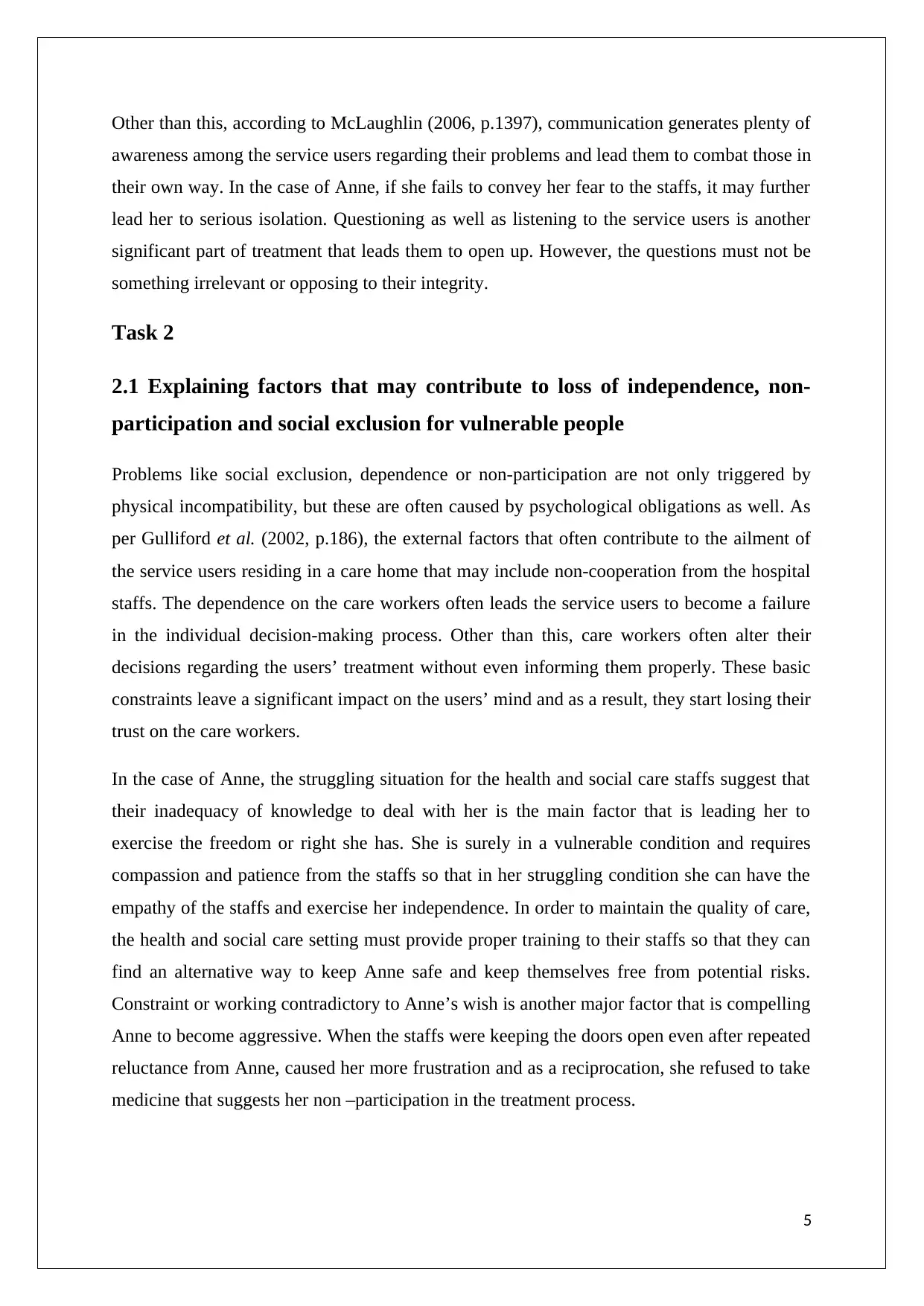
Other than this, according to McLaughlin (2006, p.1397), communication generates plenty of
awareness among the service users regarding their problems and lead them to combat those in
their own way. In the case of Anne, if she fails to convey her fear to the staffs, it may further
lead her to serious isolation. Questioning as well as listening to the service users is another
significant part of treatment that leads them to open up. However, the questions must not be
something irrelevant or opposing to their integrity.
Task 2
2.1 Explaining factors that may contribute to loss of independence, non-
participation and social exclusion for vulnerable people
Problems like social exclusion, dependence or non-participation are not only triggered by
physical incompatibility, but these are often caused by psychological obligations as well. As
per Gulliford et al. (2002, p.186), the external factors that often contribute to the ailment of
the service users residing in a care home that may include non-cooperation from the hospital
staffs. The dependence on the care workers often leads the service users to become a failure
in the individual decision-making process. Other than this, care workers often alter their
decisions regarding the users’ treatment without even informing them properly. These basic
constraints leave a significant impact on the users’ mind and as a result, they start losing their
trust on the care workers.
In the case of Anne, the struggling situation for the health and social care staffs suggest that
their inadequacy of knowledge to deal with her is the main factor that is leading her to
exercise the freedom or right she has. She is surely in a vulnerable condition and requires
compassion and patience from the staffs so that in her struggling condition she can have the
empathy of the staffs and exercise her independence. In order to maintain the quality of care,
the health and social care setting must provide proper training to their staffs so that they can
find an alternative way to keep Anne safe and keep themselves free from potential risks.
Constraint or working contradictory to Anne’s wish is another major factor that is compelling
Anne to become aggressive. When the staffs were keeping the doors open even after repeated
reluctance from Anne, caused her more frustration and as a reciprocation, she refused to take
medicine that suggests her non –participation in the treatment process.
5
awareness among the service users regarding their problems and lead them to combat those in
their own way. In the case of Anne, if she fails to convey her fear to the staffs, it may further
lead her to serious isolation. Questioning as well as listening to the service users is another
significant part of treatment that leads them to open up. However, the questions must not be
something irrelevant or opposing to their integrity.
Task 2
2.1 Explaining factors that may contribute to loss of independence, non-
participation and social exclusion for vulnerable people
Problems like social exclusion, dependence or non-participation are not only triggered by
physical incompatibility, but these are often caused by psychological obligations as well. As
per Gulliford et al. (2002, p.186), the external factors that often contribute to the ailment of
the service users residing in a care home that may include non-cooperation from the hospital
staffs. The dependence on the care workers often leads the service users to become a failure
in the individual decision-making process. Other than this, care workers often alter their
decisions regarding the users’ treatment without even informing them properly. These basic
constraints leave a significant impact on the users’ mind and as a result, they start losing their
trust on the care workers.
In the case of Anne, the struggling situation for the health and social care staffs suggest that
their inadequacy of knowledge to deal with her is the main factor that is leading her to
exercise the freedom or right she has. She is surely in a vulnerable condition and requires
compassion and patience from the staffs so that in her struggling condition she can have the
empathy of the staffs and exercise her independence. In order to maintain the quality of care,
the health and social care setting must provide proper training to their staffs so that they can
find an alternative way to keep Anne safe and keep themselves free from potential risks.
Constraint or working contradictory to Anne’s wish is another major factor that is compelling
Anne to become aggressive. When the staffs were keeping the doors open even after repeated
reluctance from Anne, caused her more frustration and as a reciprocation, she refused to take
medicine that suggests her non –participation in the treatment process.
5
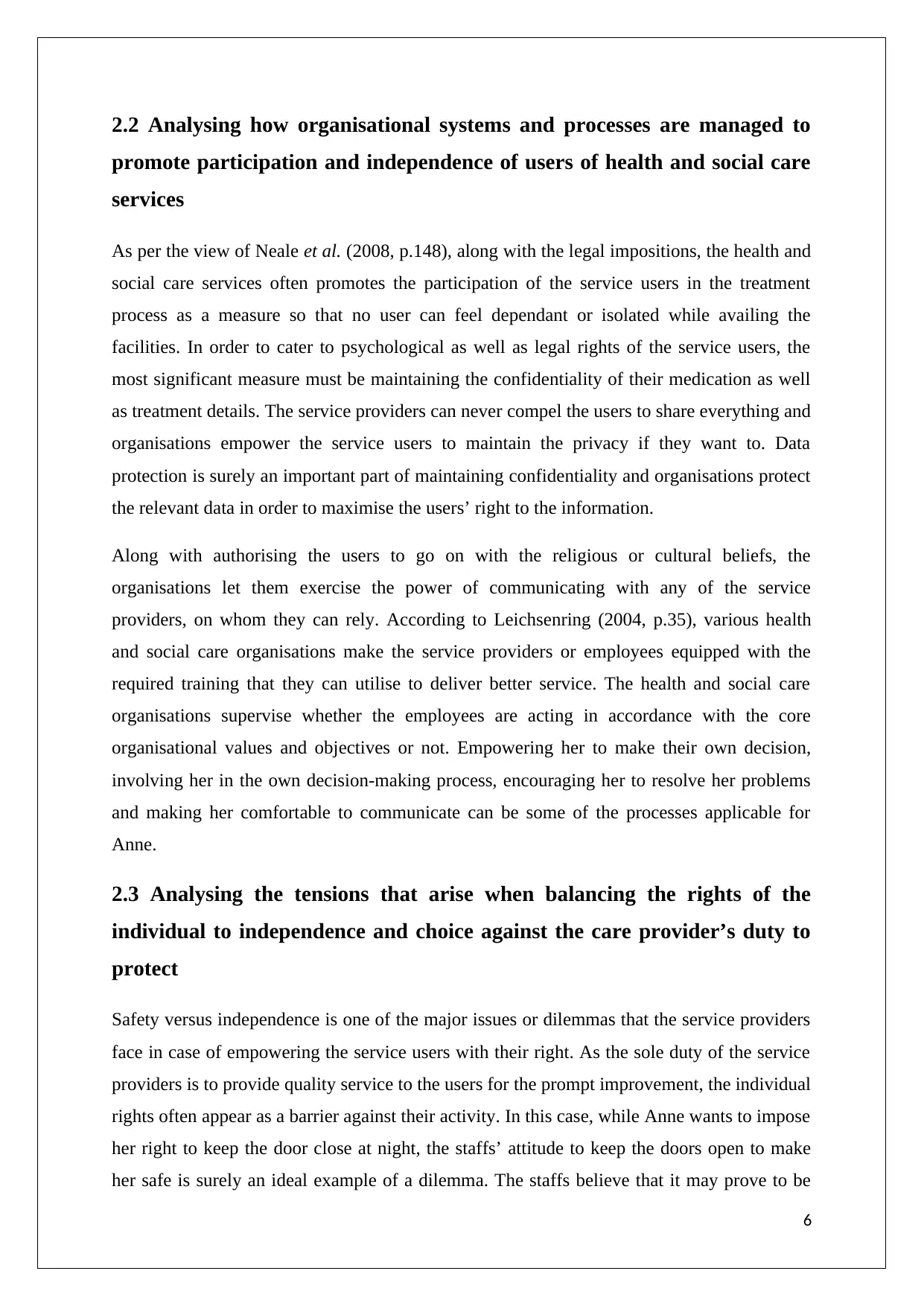
2.2 Analysing how organisational systems and processes are managed to
promote participation and independence of users of health and social care
services
As per the view of Neale et al. (2008, p.148), along with the legal impositions, the health and
social care services often promotes the participation of the service users in the treatment
process as a measure so that no user can feel dependant or isolated while availing the
facilities. In order to cater to psychological as well as legal rights of the service users, the
most significant measure must be maintaining the confidentiality of their medication as well
as treatment details. The service providers can never compel the users to share everything and
organisations empower the service users to maintain the privacy if they want to. Data
protection is surely an important part of maintaining confidentiality and organisations protect
the relevant data in order to maximise the users’ right to the information.
Along with authorising the users to go on with the religious or cultural beliefs, the
organisations let them exercise the power of communicating with any of the service
providers, on whom they can rely. According to Leichsenring (2004, p.35), various health
and social care organisations make the service providers or employees equipped with the
required training that they can utilise to deliver better service. The health and social care
organisations supervise whether the employees are acting in accordance with the core
organisational values and objectives or not. Empowering her to make their own decision,
involving her in the own decision-making process, encouraging her to resolve her problems
and making her comfortable to communicate can be some of the processes applicable for
Anne.
2.3 Analysing the tensions that arise when balancing the rights of the
individual to independence and choice against the care provider’s duty to
protect
Safety versus independence is one of the major issues or dilemmas that the service providers
face in case of empowering the service users with their right. As the sole duty of the service
providers is to provide quality service to the users for the prompt improvement, the individual
rights often appear as a barrier against their activity. In this case, while Anne wants to impose
her right to keep the door close at night, the staffs’ attitude to keep the doors open to make
her safe is surely an ideal example of a dilemma. The staffs believe that it may prove to be
6
promote participation and independence of users of health and social care
services
As per the view of Neale et al. (2008, p.148), along with the legal impositions, the health and
social care services often promotes the participation of the service users in the treatment
process as a measure so that no user can feel dependant or isolated while availing the
facilities. In order to cater to psychological as well as legal rights of the service users, the
most significant measure must be maintaining the confidentiality of their medication as well
as treatment details. The service providers can never compel the users to share everything and
organisations empower the service users to maintain the privacy if they want to. Data
protection is surely an important part of maintaining confidentiality and organisations protect
the relevant data in order to maximise the users’ right to the information.
Along with authorising the users to go on with the religious or cultural beliefs, the
organisations let them exercise the power of communicating with any of the service
providers, on whom they can rely. According to Leichsenring (2004, p.35), various health
and social care organisations make the service providers or employees equipped with the
required training that they can utilise to deliver better service. The health and social care
organisations supervise whether the employees are acting in accordance with the core
organisational values and objectives or not. Empowering her to make their own decision,
involving her in the own decision-making process, encouraging her to resolve her problems
and making her comfortable to communicate can be some of the processes applicable for
Anne.
2.3 Analysing the tensions that arise when balancing the rights of the
individual to independence and choice against the care provider’s duty to
protect
Safety versus independence is one of the major issues or dilemmas that the service providers
face in case of empowering the service users with their right. As the sole duty of the service
providers is to provide quality service to the users for the prompt improvement, the individual
rights often appear as a barrier against their activity. In this case, while Anne wants to impose
her right to keep the door close at night, the staffs’ attitude to keep the doors open to make
her safe is surely an ideal example of a dilemma. The staffs believe that it may prove to be
6
⊘ This is a preview!⊘
Do you want full access?
Subscribe today to unlock all pages.

Trusted by 1+ million students worldwide
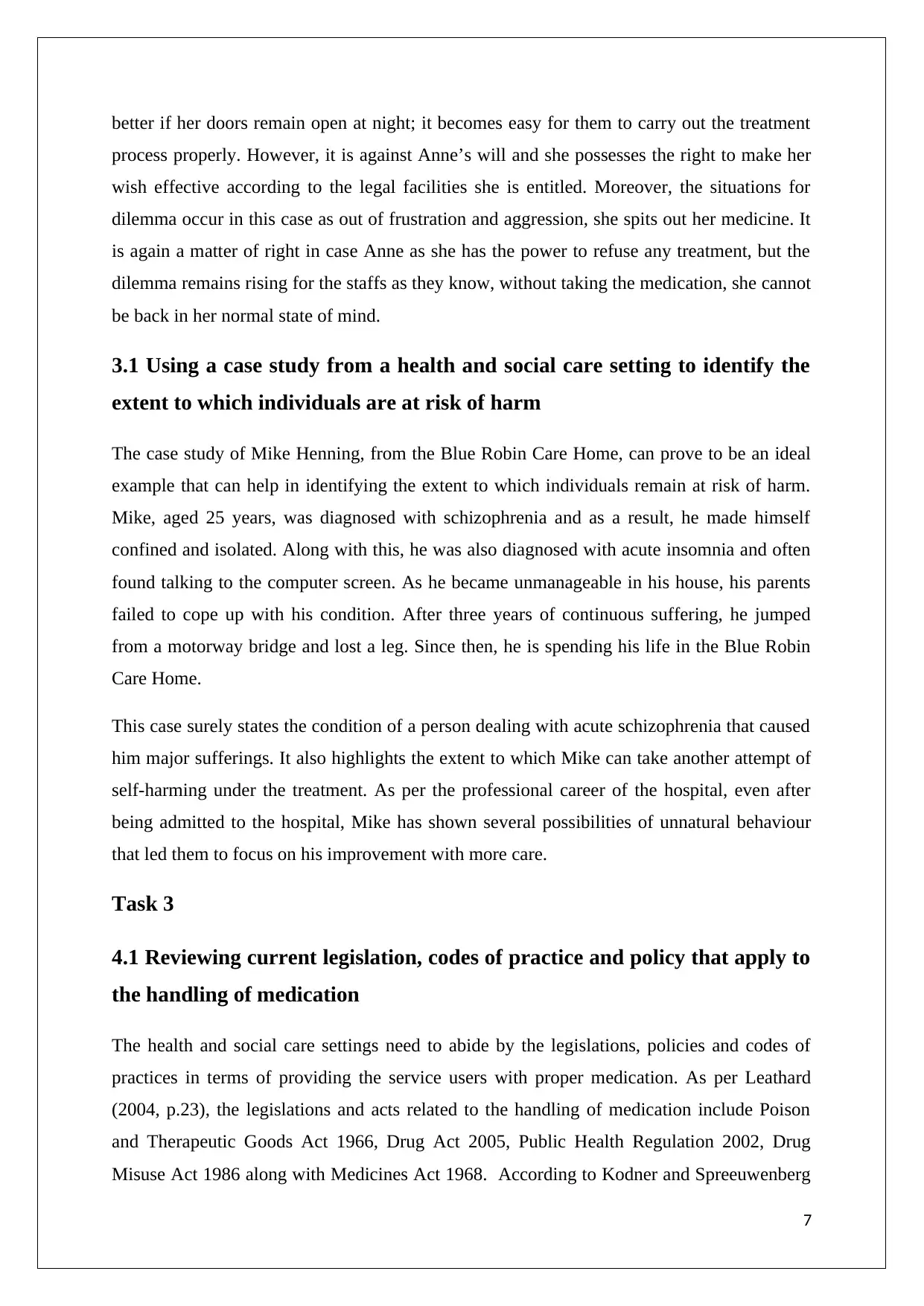
better if her doors remain open at night; it becomes easy for them to carry out the treatment
process properly. However, it is against Anne’s will and she possesses the right to make her
wish effective according to the legal facilities she is entitled. Moreover, the situations for
dilemma occur in this case as out of frustration and aggression, she spits out her medicine. It
is again a matter of right in case Anne as she has the power to refuse any treatment, but the
dilemma remains rising for the staffs as they know, without taking the medication, she cannot
be back in her normal state of mind.
3.1 Using a case study from a health and social care setting to identify the
extent to which individuals are at risk of harm
The case study of Mike Henning, from the Blue Robin Care Home, can prove to be an ideal
example that can help in identifying the extent to which individuals remain at risk of harm.
Mike, aged 25 years, was diagnosed with schizophrenia and as a result, he made himself
confined and isolated. Along with this, he was also diagnosed with acute insomnia and often
found talking to the computer screen. As he became unmanageable in his house, his parents
failed to cope up with his condition. After three years of continuous suffering, he jumped
from a motorway bridge and lost a leg. Since then, he is spending his life in the Blue Robin
Care Home.
This case surely states the condition of a person dealing with acute schizophrenia that caused
him major sufferings. It also highlights the extent to which Mike can take another attempt of
self-harming under the treatment. As per the professional career of the hospital, even after
being admitted to the hospital, Mike has shown several possibilities of unnatural behaviour
that led them to focus on his improvement with more care.
Task 3
4.1 Reviewing current legislation, codes of practice and policy that apply to
the handling of medication
The health and social care settings need to abide by the legislations, policies and codes of
practices in terms of providing the service users with proper medication. As per Leathard
(2004, p.23), the legislations and acts related to the handling of medication include Poison
and Therapeutic Goods Act 1966, Drug Act 2005, Public Health Regulation 2002, Drug
Misuse Act 1986 along with Medicines Act 1968. According to Kodner and Spreeuwenberg
7
process properly. However, it is against Anne’s will and she possesses the right to make her
wish effective according to the legal facilities she is entitled. Moreover, the situations for
dilemma occur in this case as out of frustration and aggression, she spits out her medicine. It
is again a matter of right in case Anne as she has the power to refuse any treatment, but the
dilemma remains rising for the staffs as they know, without taking the medication, she cannot
be back in her normal state of mind.
3.1 Using a case study from a health and social care setting to identify the
extent to which individuals are at risk of harm
The case study of Mike Henning, from the Blue Robin Care Home, can prove to be an ideal
example that can help in identifying the extent to which individuals remain at risk of harm.
Mike, aged 25 years, was diagnosed with schizophrenia and as a result, he made himself
confined and isolated. Along with this, he was also diagnosed with acute insomnia and often
found talking to the computer screen. As he became unmanageable in his house, his parents
failed to cope up with his condition. After three years of continuous suffering, he jumped
from a motorway bridge and lost a leg. Since then, he is spending his life in the Blue Robin
Care Home.
This case surely states the condition of a person dealing with acute schizophrenia that caused
him major sufferings. It also highlights the extent to which Mike can take another attempt of
self-harming under the treatment. As per the professional career of the hospital, even after
being admitted to the hospital, Mike has shown several possibilities of unnatural behaviour
that led them to focus on his improvement with more care.
Task 3
4.1 Reviewing current legislation, codes of practice and policy that apply to
the handling of medication
The health and social care settings need to abide by the legislations, policies and codes of
practices in terms of providing the service users with proper medication. As per Leathard
(2004, p.23), the legislations and acts related to the handling of medication include Poison
and Therapeutic Goods Act 1966, Drug Act 2005, Public Health Regulation 2002, Drug
Misuse Act 1986 along with Medicines Act 1968. According to Kodner and Spreeuwenberg
7
Paraphrase This Document
Need a fresh take? Get an instant paraphrase of this document with our AI Paraphraser
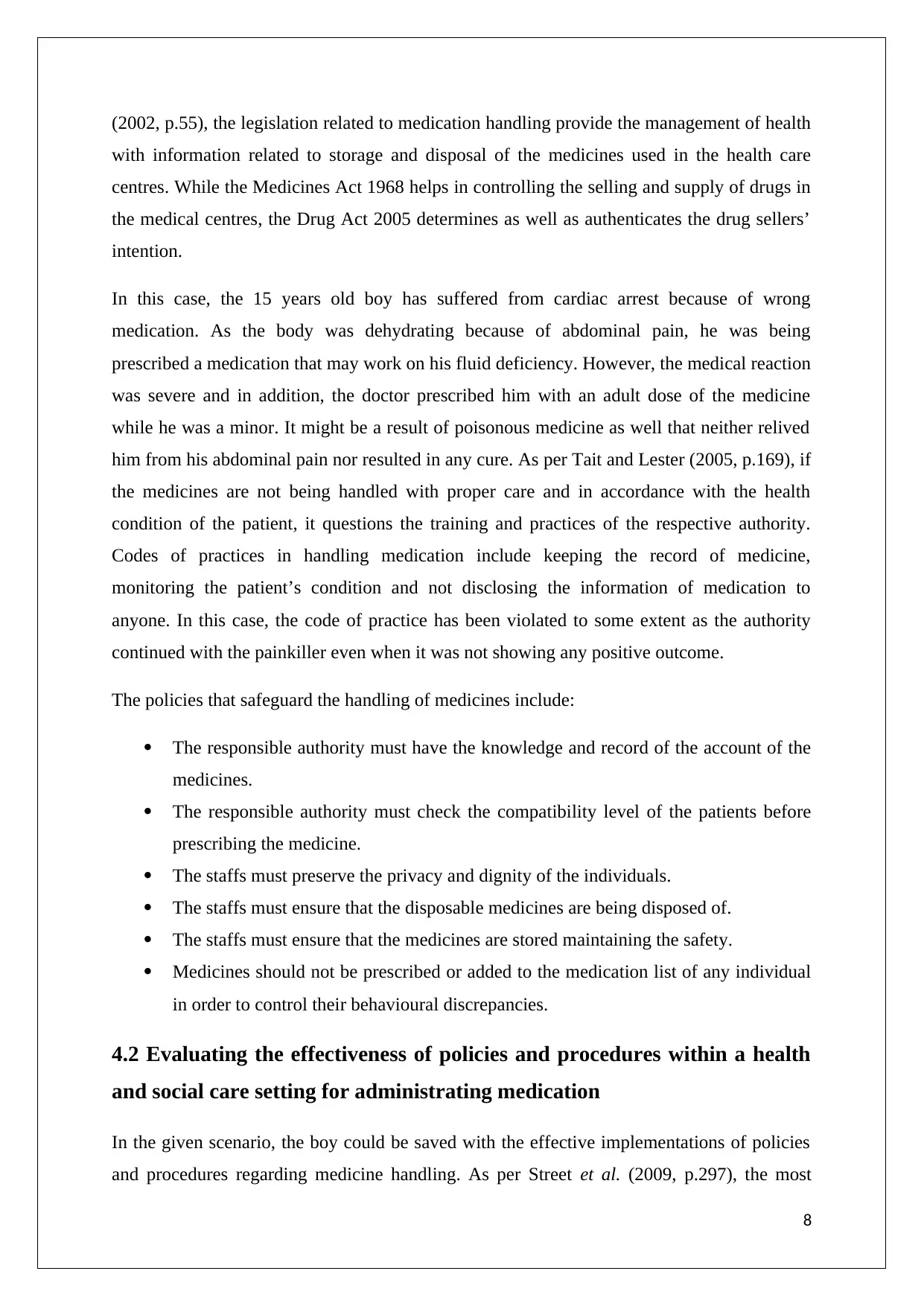
(2002, p.55), the legislation related to medication handling provide the management of health
with information related to storage and disposal of the medicines used in the health care
centres. While the Medicines Act 1968 helps in controlling the selling and supply of drugs in
the medical centres, the Drug Act 2005 determines as well as authenticates the drug sellers’
intention.
In this case, the 15 years old boy has suffered from cardiac arrest because of wrong
medication. As the body was dehydrating because of abdominal pain, he was being
prescribed a medication that may work on his fluid deficiency. However, the medical reaction
was severe and in addition, the doctor prescribed him with an adult dose of the medicine
while he was a minor. It might be a result of poisonous medicine as well that neither relived
him from his abdominal pain nor resulted in any cure. As per Tait and Lester (2005, p.169), if
the medicines are not being handled with proper care and in accordance with the health
condition of the patient, it questions the training and practices of the respective authority.
Codes of practices in handling medication include keeping the record of medicine,
monitoring the patient’s condition and not disclosing the information of medication to
anyone. In this case, the code of practice has been violated to some extent as the authority
continued with the painkiller even when it was not showing any positive outcome.
The policies that safeguard the handling of medicines include:
The responsible authority must have the knowledge and record of the account of the
medicines.
The responsible authority must check the compatibility level of the patients before
prescribing the medicine.
The staffs must preserve the privacy and dignity of the individuals.
The staffs must ensure that the disposable medicines are being disposed of.
The staffs must ensure that the medicines are stored maintaining the safety.
Medicines should not be prescribed or added to the medication list of any individual
in order to control their behavioural discrepancies.
4.2 Evaluating the effectiveness of policies and procedures within a health
and social care setting for administrating medication
In the given scenario, the boy could be saved with the effective implementations of policies
and procedures regarding medicine handling. As per Street et al. (2009, p.297), the most
8
with information related to storage and disposal of the medicines used in the health care
centres. While the Medicines Act 1968 helps in controlling the selling and supply of drugs in
the medical centres, the Drug Act 2005 determines as well as authenticates the drug sellers’
intention.
In this case, the 15 years old boy has suffered from cardiac arrest because of wrong
medication. As the body was dehydrating because of abdominal pain, he was being
prescribed a medication that may work on his fluid deficiency. However, the medical reaction
was severe and in addition, the doctor prescribed him with an adult dose of the medicine
while he was a minor. It might be a result of poisonous medicine as well that neither relived
him from his abdominal pain nor resulted in any cure. As per Tait and Lester (2005, p.169), if
the medicines are not being handled with proper care and in accordance with the health
condition of the patient, it questions the training and practices of the respective authority.
Codes of practices in handling medication include keeping the record of medicine,
monitoring the patient’s condition and not disclosing the information of medication to
anyone. In this case, the code of practice has been violated to some extent as the authority
continued with the painkiller even when it was not showing any positive outcome.
The policies that safeguard the handling of medicines include:
The responsible authority must have the knowledge and record of the account of the
medicines.
The responsible authority must check the compatibility level of the patients before
prescribing the medicine.
The staffs must preserve the privacy and dignity of the individuals.
The staffs must ensure that the disposable medicines are being disposed of.
The staffs must ensure that the medicines are stored maintaining the safety.
Medicines should not be prescribed or added to the medication list of any individual
in order to control their behavioural discrepancies.
4.2 Evaluating the effectiveness of policies and procedures within a health
and social care setting for administrating medication
In the given scenario, the boy could be saved with the effective implementations of policies
and procedures regarding medicine handling. As per Street et al. (2009, p.297), the most
8
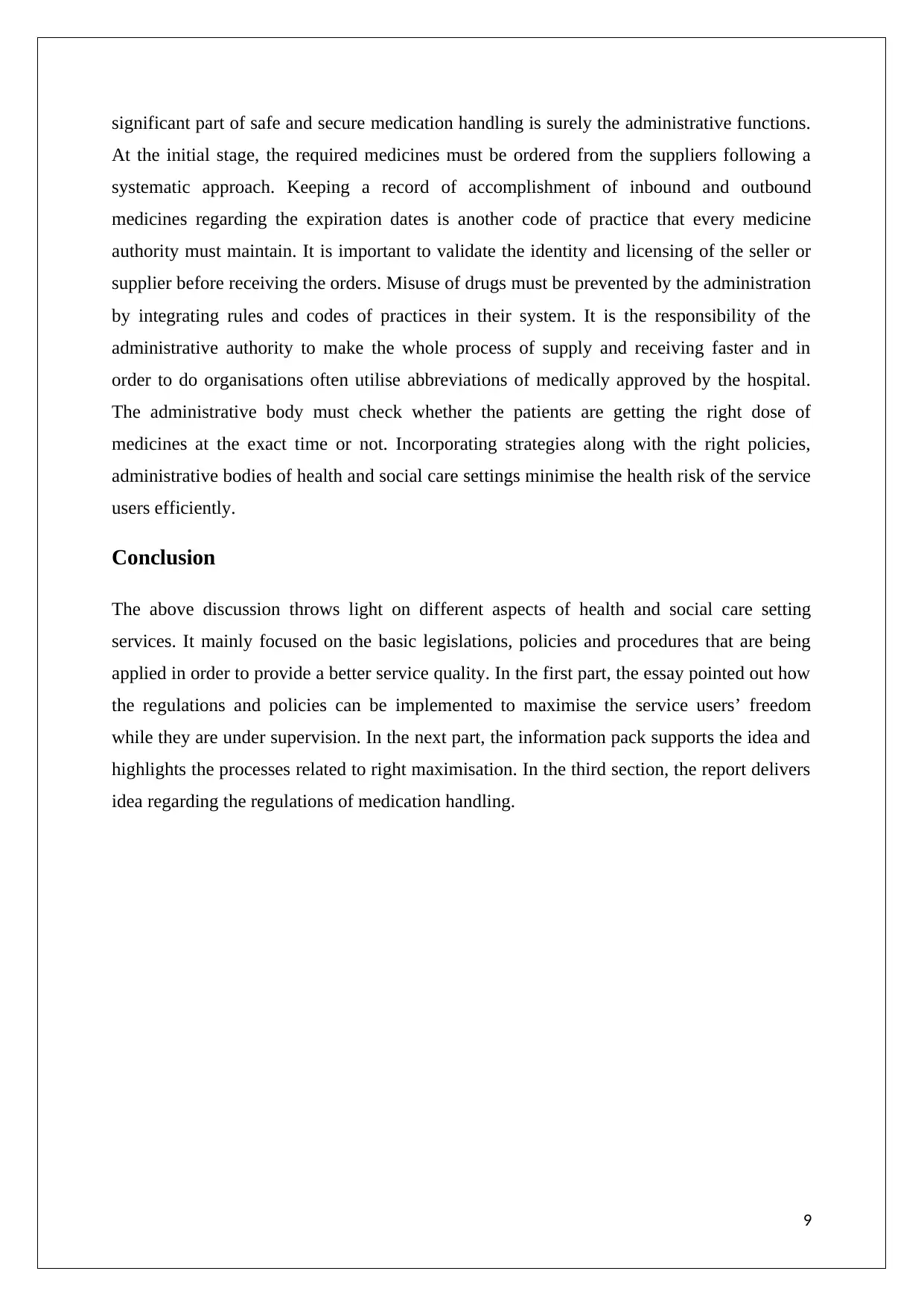
significant part of safe and secure medication handling is surely the administrative functions.
At the initial stage, the required medicines must be ordered from the suppliers following a
systematic approach. Keeping a record of accomplishment of inbound and outbound
medicines regarding the expiration dates is another code of practice that every medicine
authority must maintain. It is important to validate the identity and licensing of the seller or
supplier before receiving the orders. Misuse of drugs must be prevented by the administration
by integrating rules and codes of practices in their system. It is the responsibility of the
administrative authority to make the whole process of supply and receiving faster and in
order to do organisations often utilise abbreviations of medically approved by the hospital.
The administrative body must check whether the patients are getting the right dose of
medicines at the exact time or not. Incorporating strategies along with the right policies,
administrative bodies of health and social care settings minimise the health risk of the service
users efficiently.
Conclusion
The above discussion throws light on different aspects of health and social care setting
services. It mainly focused on the basic legislations, policies and procedures that are being
applied in order to provide a better service quality. In the first part, the essay pointed out how
the regulations and policies can be implemented to maximise the service users’ freedom
while they are under supervision. In the next part, the information pack supports the idea and
highlights the processes related to right maximisation. In the third section, the report delivers
idea regarding the regulations of medication handling.
9
At the initial stage, the required medicines must be ordered from the suppliers following a
systematic approach. Keeping a record of accomplishment of inbound and outbound
medicines regarding the expiration dates is another code of practice that every medicine
authority must maintain. It is important to validate the identity and licensing of the seller or
supplier before receiving the orders. Misuse of drugs must be prevented by the administration
by integrating rules and codes of practices in their system. It is the responsibility of the
administrative authority to make the whole process of supply and receiving faster and in
order to do organisations often utilise abbreviations of medically approved by the hospital.
The administrative body must check whether the patients are getting the right dose of
medicines at the exact time or not. Incorporating strategies along with the right policies,
administrative bodies of health and social care settings minimise the health risk of the service
users efficiently.
Conclusion
The above discussion throws light on different aspects of health and social care setting
services. It mainly focused on the basic legislations, policies and procedures that are being
applied in order to provide a better service quality. In the first part, the essay pointed out how
the regulations and policies can be implemented to maximise the service users’ freedom
while they are under supervision. In the next part, the information pack supports the idea and
highlights the processes related to right maximisation. In the third section, the report delivers
idea regarding the regulations of medication handling.
9
⊘ This is a preview!⊘
Do you want full access?
Subscribe today to unlock all pages.

Trusted by 1+ million students worldwide
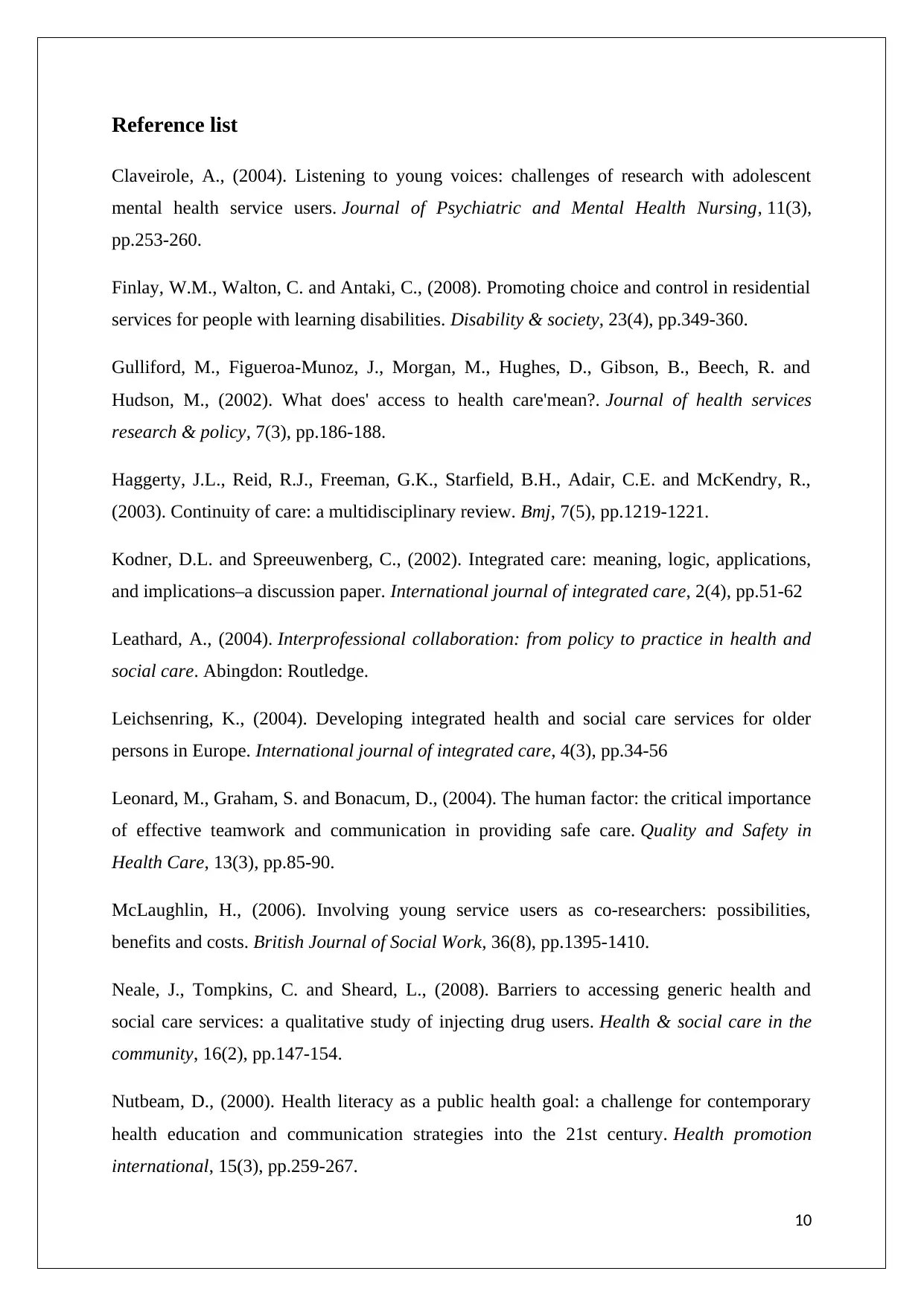
Reference list
Claveirole, A., (2004). Listening to young voices: challenges of research with adolescent
mental health service users. Journal of Psychiatric and Mental Health Nursing, 11(3),
pp.253-260.
Finlay, W.M., Walton, C. and Antaki, C., (2008). Promoting choice and control in residential
services for people with learning disabilities. Disability & society, 23(4), pp.349-360.
Gulliford, M., Figueroa-Munoz, J., Morgan, M., Hughes, D., Gibson, B., Beech, R. and
Hudson, M., (2002). What does' access to health care'mean?. Journal of health services
research & policy, 7(3), pp.186-188.
Haggerty, J.L., Reid, R.J., Freeman, G.K., Starfield, B.H., Adair, C.E. and McKendry, R.,
(2003). Continuity of care: a multidisciplinary review. Bmj, 7(5), pp.1219-1221.
Kodner, D.L. and Spreeuwenberg, C., (2002). Integrated care: meaning, logic, applications,
and implications–a discussion paper. International journal of integrated care, 2(4), pp.51-62
Leathard, A., (2004). Interprofessional collaboration: from policy to practice in health and
social care. Abingdon: Routledge.
Leichsenring, K., (2004). Developing integrated health and social care services for older
persons in Europe. International journal of integrated care, 4(3), pp.34-56
Leonard, M., Graham, S. and Bonacum, D., (2004). The human factor: the critical importance
of effective teamwork and communication in providing safe care. Quality and Safety in
Health Care, 13(3), pp.85-90.
McLaughlin, H., (2006). Involving young service users as co-researchers: possibilities,
benefits and costs. British Journal of Social Work, 36(8), pp.1395-1410.
Neale, J., Tompkins, C. and Sheard, L., (2008). Barriers to accessing generic health and
social care services: a qualitative study of injecting drug users. Health & social care in the
community, 16(2), pp.147-154.
Nutbeam, D., (2000). Health literacy as a public health goal: a challenge for contemporary
health education and communication strategies into the 21st century. Health promotion
international, 15(3), pp.259-267.
10
Claveirole, A., (2004). Listening to young voices: challenges of research with adolescent
mental health service users. Journal of Psychiatric and Mental Health Nursing, 11(3),
pp.253-260.
Finlay, W.M., Walton, C. and Antaki, C., (2008). Promoting choice and control in residential
services for people with learning disabilities. Disability & society, 23(4), pp.349-360.
Gulliford, M., Figueroa-Munoz, J., Morgan, M., Hughes, D., Gibson, B., Beech, R. and
Hudson, M., (2002). What does' access to health care'mean?. Journal of health services
research & policy, 7(3), pp.186-188.
Haggerty, J.L., Reid, R.J., Freeman, G.K., Starfield, B.H., Adair, C.E. and McKendry, R.,
(2003). Continuity of care: a multidisciplinary review. Bmj, 7(5), pp.1219-1221.
Kodner, D.L. and Spreeuwenberg, C., (2002). Integrated care: meaning, logic, applications,
and implications–a discussion paper. International journal of integrated care, 2(4), pp.51-62
Leathard, A., (2004). Interprofessional collaboration: from policy to practice in health and
social care. Abingdon: Routledge.
Leichsenring, K., (2004). Developing integrated health and social care services for older
persons in Europe. International journal of integrated care, 4(3), pp.34-56
Leonard, M., Graham, S. and Bonacum, D., (2004). The human factor: the critical importance
of effective teamwork and communication in providing safe care. Quality and Safety in
Health Care, 13(3), pp.85-90.
McLaughlin, H., (2006). Involving young service users as co-researchers: possibilities,
benefits and costs. British Journal of Social Work, 36(8), pp.1395-1410.
Neale, J., Tompkins, C. and Sheard, L., (2008). Barriers to accessing generic health and
social care services: a qualitative study of injecting drug users. Health & social care in the
community, 16(2), pp.147-154.
Nutbeam, D., (2000). Health literacy as a public health goal: a challenge for contemporary
health education and communication strategies into the 21st century. Health promotion
international, 15(3), pp.259-267.
10
Paraphrase This Document
Need a fresh take? Get an instant paraphrase of this document with our AI Paraphraser
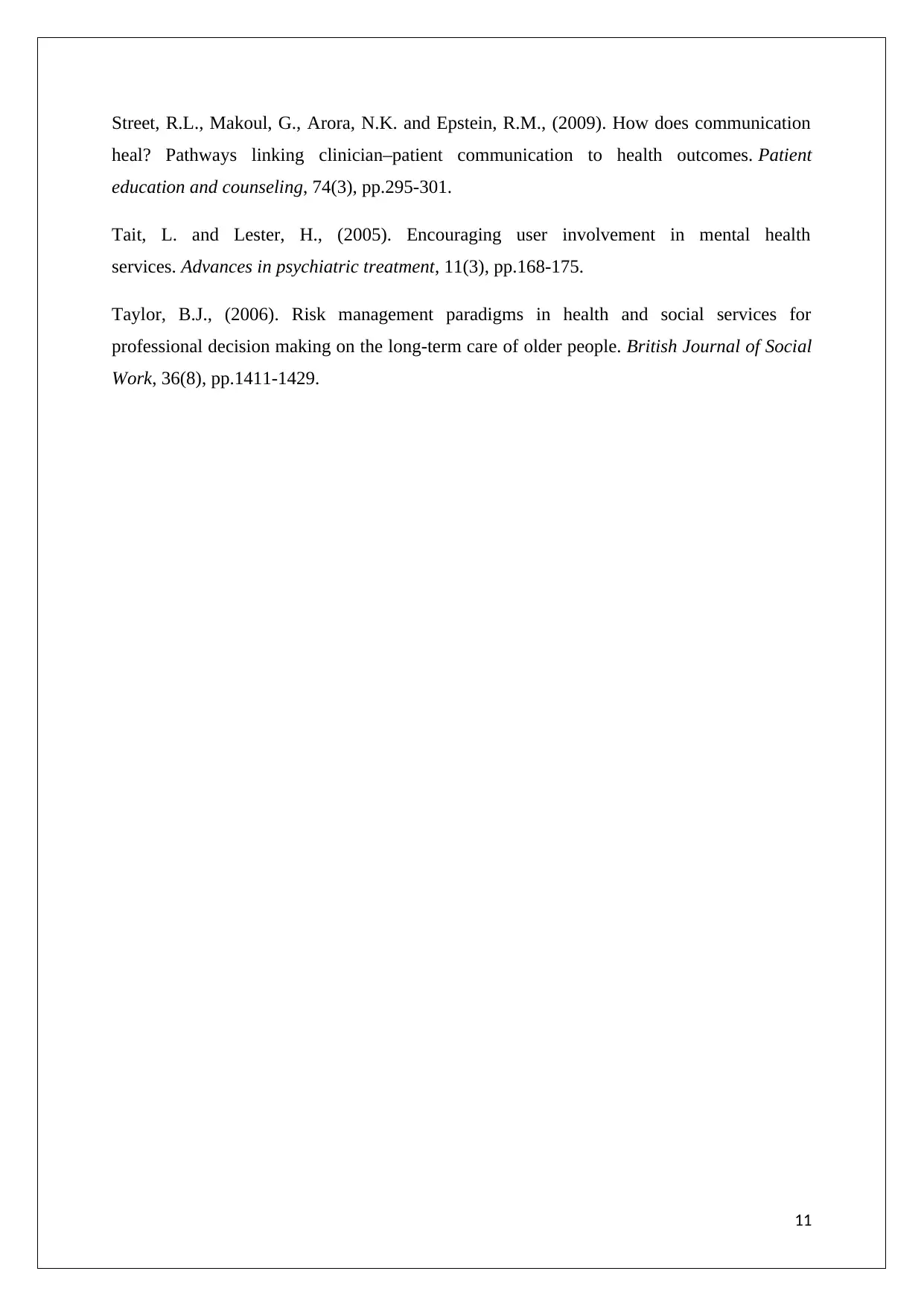
Street, R.L., Makoul, G., Arora, N.K. and Epstein, R.M., (2009). How does communication
heal? Pathways linking clinician–patient communication to health outcomes. Patient
education and counseling, 74(3), pp.295-301.
Tait, L. and Lester, H., (2005). Encouraging user involvement in mental health
services. Advances in psychiatric treatment, 11(3), pp.168-175.
Taylor, B.J., (2006). Risk management paradigms in health and social services for
professional decision making on the long-term care of older people. British Journal of Social
Work, 36(8), pp.1411-1429.
11
heal? Pathways linking clinician–patient communication to health outcomes. Patient
education and counseling, 74(3), pp.295-301.
Tait, L. and Lester, H., (2005). Encouraging user involvement in mental health
services. Advances in psychiatric treatment, 11(3), pp.168-175.
Taylor, B.J., (2006). Risk management paradigms in health and social services for
professional decision making on the long-term care of older people. British Journal of Social
Work, 36(8), pp.1411-1429.
11
1 out of 11
Related Documents
Your All-in-One AI-Powered Toolkit for Academic Success.
+13062052269
info@desklib.com
Available 24*7 on WhatsApp / Email
![[object Object]](/_next/static/media/star-bottom.7253800d.svg)
Unlock your academic potential
Copyright © 2020–2025 A2Z Services. All Rights Reserved. Developed and managed by ZUCOL.





